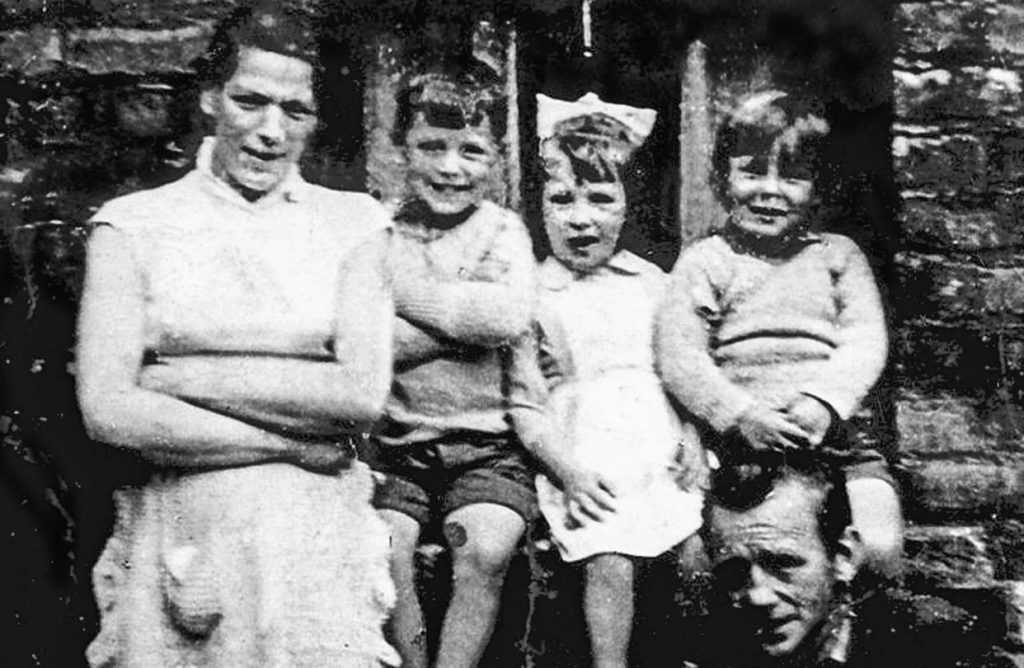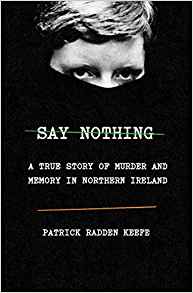Say Nothing by Patrick Radden Keefe is subtitled A True Story of Murder and Memory in Northern Ireland. It is very rare for me to ignore everything around me and become completely immersed in a book, no matter how great or suspenseful it is, but that is exactly what happened with this one. Watch the video below or skip down to read the full review.
Being across the ocean, I really didn’t know that much about life in Northern Ireland during The Troubles, which stretched from 1968 to 1998, at the time events were happening. I first became aware of the deep divisions only after I began researching my ancestry, which led to Ballygawley, County Tyrone, Northern Ireland. During trips there, I visited Belfast and took the bus tours which included much about The Troubles and brought me past the Peace Walls and art commemorating both sides. In fact, one of the last British soldiers to be killed had the same last name as my ancestors (Neely), who was killed in an IRA bomb attack outside Ballygawley.

So when I came across the story of Jean McConville, a 38-year-old mother of 10 children who was abducted and murdered by the IRA, I was intrigued. Who would burst into someone’s home, knowing the father had died of cancer, and remove the mother of children as young as six years of age right in front of them, take her to a remote location and murder her? They had to have known the children would be left on their own, perhaps even to die without adult care. And why would anyone be that inhumane?
Patrick Radden Keefe’s book, Say Nothing, answers those questions in a very balanced way. Being a journalist by trade—a New Yorker Magazine award-winning journalist—I immediately knew from the level of detail that he had painstakingly researched not only Jean McConville and her family but also each of the individuals that had some level of participation in her abduction and murder. The result is an absolutely riveting story that delves deep into what causes people to become terrorists, the changes that occur in a person’s mind when they are raised among extreme levels of hatred and the extent to which they will go because they believe in a cause larger than themselves.
What was particularly striking was the revelation that many of the people involved in acts of terror—the bombing of London and Northern Ireland and the killing of innocent civilians—suffered abnormally high rates of drug dependency, alcoholism and PTSD after The Troubles had officially ended with the Good Friday Peace Agreement of 1998. The agreement caused the IRA to stand down, the British to release political prisoners held without trial or conviction, but it fell short of turning Northern Ireland over to the Irish Republicans. Because that was the goal of the IRA, members were left wondering what the killing and maiming was all about if their leaders were willing to simply give up the goal and work with the British politically through Sinn Fein.
In Jean McConville’s case—the central subject of this book—she was a Protestant that had taken work as a domestic in a Catholic household, subsequently falling in love with her boss’ Catholic son. In America, this would not have been perceived as a problem at all. In Northern Ireland, it led to the kiss of death and a generation of children traumatized by their father’s death, their mother’s murder and their subsequent separation and hellish time in abusive, Catholic-run children’s homes that seem right out of a Charles Dickens novel.

The investigations into Jean McConville’s disappearance would lead to Dolours and Marian Price—it is Dolours’ picture that appears on the front cover, her face partially hidden consistent with IRA terrorists of the time. The damning evidence was in the form of Dolours’ own voice as she participated in a Boston College project in which she admitted on audiotape that she drove McConville across the border to Dundalk in the Republic of Ireland. Later, when the men instructed to kill her did not want to do that because McConville was a widowed mother of ten, Dolours drove back to Dundalk with two others, assumed to be her sister Marian and Ivor Bell, and murdered McConville, burying her in an unmarked grave. It would take decades and particularly strong storms to erode the ground in which she’d been hastily buried, for her body to be found. By that time, her children were grown and had families of their own.
We do find out who fired the fatal shot that killed Jean McConville (no spoilers here). But the story is far larger than that. It is the story of a country that had been invaded by foreign forces more than 700 years ago and divided in the early 20th century so that one part of the country became the free and independent Republic of Ireland while the other part remained a colony controlled by Great Britain. It is the story of those loyal to the United Kingdom as well as those carrying on a tradition of a free Ireland for which their ancestors fought for hundreds of years. It is also the story of supposed men of God—priests and ministers—who fueled the hatred within their communities, leading to spiraling violence and extremism on both sides. With Brexit, tensions have once again increased between the two factions and ultimately, it will be London who will decide its fate.
I highly recommend this book. Be prepared for a riveting tale and a book you can’t put down.
